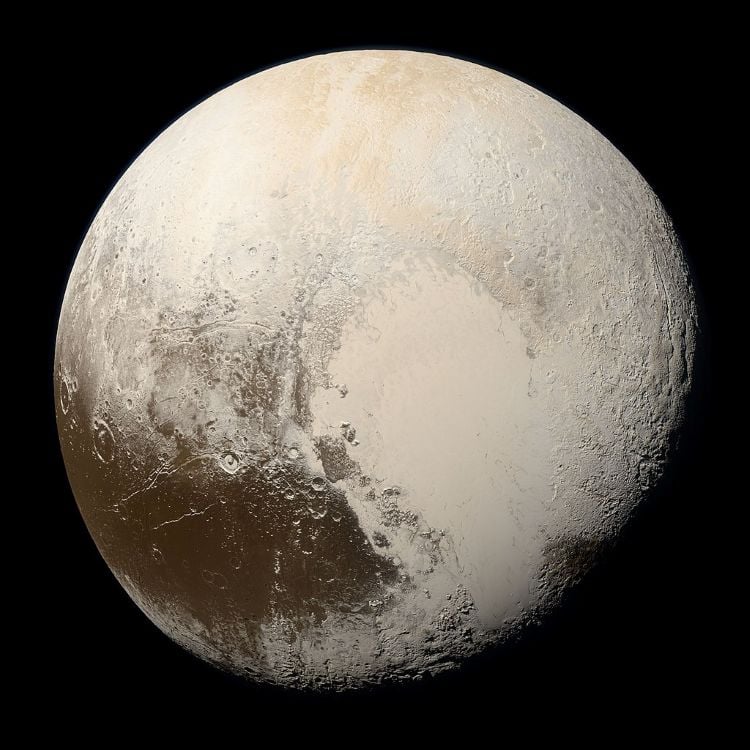Science
Study Reveals Signs of Cryovolcanism on Pluto’s Kildaze Caldera

Recent research has identified potential signs of cryovolcanism in the Kildaze caldera located in Pluto’s Hayabusa Terra region. A study published in *The Planetary Science Journal* examines how this icy geological activity may provide insights into Pluto’s current geological processes and its ability to sustain such activity far from the Sun.
The research team analyzed images captured by NASA’s New Horizons spacecraft during its historic flyby of Pluto in July 2015. By comparing these images with known cryovolcanic sites on Pluto, such as Virgil Fossae and Viking Terra, as well as analog sites on Earth and Mars, they sought to uncover evidence of past cryovolcanic events.
Investigating Cryovolcanic Activity
To delve into the origins of the water ice found at Kildaze, researchers employed various tools, including digital elevation models and 3D visualizations. Their findings suggest that the water ice is likely a few million years old, significantly younger than Pluto itself. The study posits that Kildaze is a cryovolcano with a caldera structure, having experienced one or more eruptions that ejected approximately 1,000 km³ of cryolava.
Cryovolcanism, which involves the eruption of icy “magma” rather than traditional hot lava, has been observed on numerous celestial bodies, including Ceres, Europa, and Titan. This phenomenon raises questions about the internal processes that can sustain such activity, especially in a distant location like Pluto.
Potential sources of cryovolcanism include external factors such as impacts from other celestial bodies, tidal heating from gravitational interactions—especially with Pluto’s largest moon, Charon—and internal heat generated from radioactive decay within the planet’s core. A 2022 study published in *Icarus* suggested that Pluto’s internal heat may be largely due to tidal interactions with Charon, allowing it to retain warmth long after its initial formation.
The Future of Pluto Exploration
Since the flyby of New Horizons, which took nearly nine years to reach Pluto, no other spacecraft have visited the dwarf planet. Nonetheless, several ambitious missions are being proposed, including an orbiter-lander combination that could reach Pluto in just four years by utilizing a fusion reactor.
As scientists continue to analyze the data returned by New Horizons, they hope to unlock more secrets surrounding Pluto’s geological activity and its potential for cryovolcanism. The ongoing exploration of Pluto’s unique features is likely to yield further insights into the dwarf planet’s past and present, keeping the scientific community engaged in this fascinating field of study.
With ongoing research and future missions on the horizon, the quest to understand Pluto’s cryovolcanic activity remains an intriguing frontier in planetary science.
-

 Science2 weeks ago
Science2 weeks agoIROS 2025 to Showcase Cutting-Edge Robotics Innovations in China
-

 Politics2 weeks ago
Politics2 weeks agoJudge Considers Dismissal of Chelsea Housing Case Citing AI Flaws
-

 World2 weeks ago
World2 weeks agoBravo Company Veterans Honored with Bronze Medals After 56 Years
-

 Top Stories2 weeks ago
Top Stories2 weeks agoIndonesia Suspends 27,000 Bank Accounts in Online Gambling Crackdown
-

 Lifestyle2 weeks ago
Lifestyle2 weeks agoStone Island’s Logo Worn by Extremists Sparks Brand Dilemma
-

 Sports2 weeks ago
Sports2 weeks agoMel Kiper Jr. Reveals Top 25 Prospects for 2026 NFL Draft
-

 Health2 weeks ago
Health2 weeks agoStartup Liberate Bio Secures $31 Million for Next-Gen Therapies
-

 Health2 weeks ago
Health2 weeks agoTop Hyaluronic Acid Serums for Radiant Skin in 2025
-

 World2 weeks ago
World2 weeks agoHoneywell Predicts Record Demand for Business Jets Over Next Decade
-

 Politics2 weeks ago
Politics2 weeks agoNew Jersey Voters Urged to Register Ahead of November Election
-

 Lifestyle2 weeks ago
Lifestyle2 weeks agoMary Morgan Jackson Crowned Little Miss National Peanut Festival 2025
-

 Sports2 weeks ago
Sports2 weeks agoYamamoto’s Mastery Leads Dodgers to 5-1 Victory in NLCS Game 2









